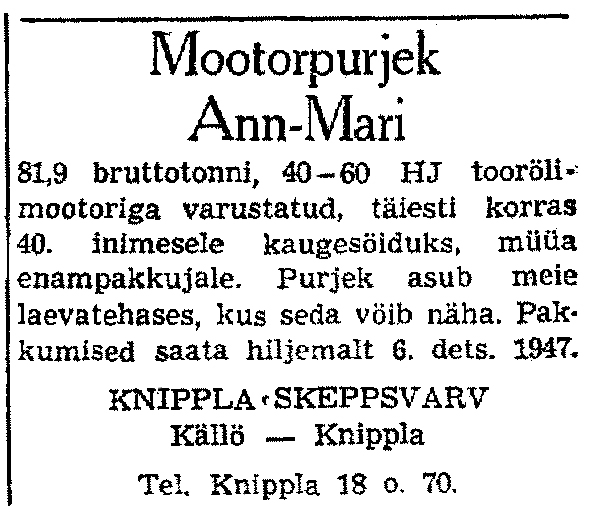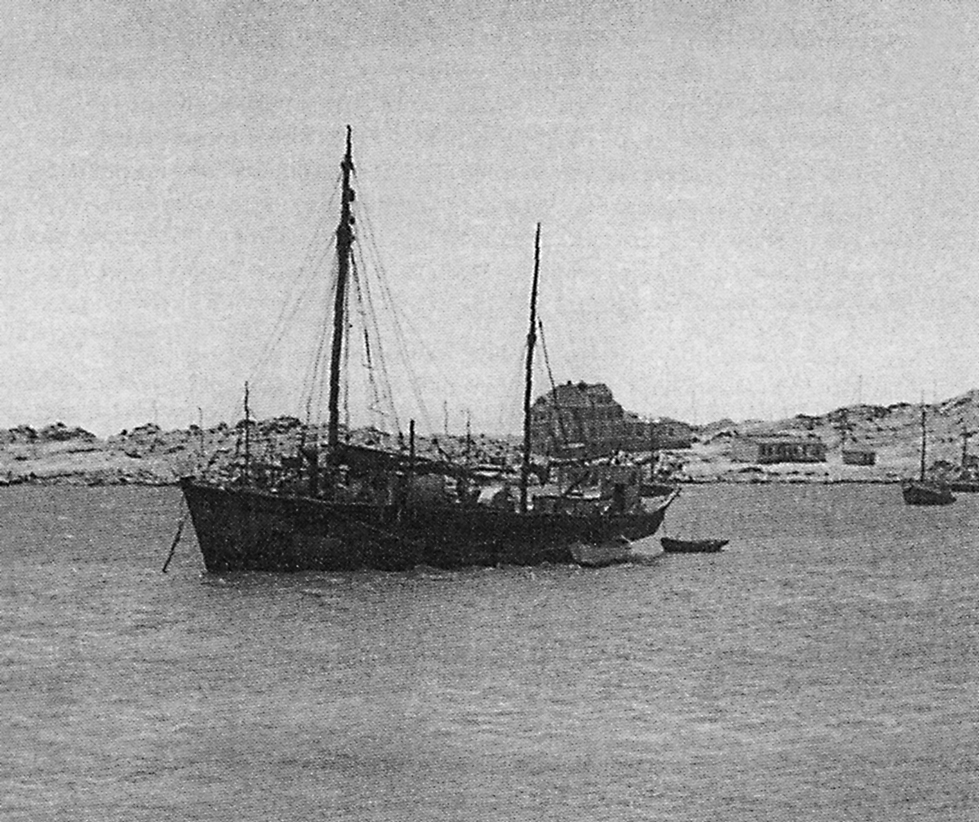Boats

Annonsen för Ann-Mari, Stockholms-Tidningen Eestlastele, 28 november 1947.
ANN-MARI
Den 28 november 1947 dök det upp en annons i Stockholms-Tidningen Eestlastele med titeln “Motoförsedd segelbåt Ann-Mari.” Notisen meddelade att båten kunde ackommodera 40 passagerare för långdistanssegling och skulle säljas till högsta budgivare.
Det slutgiltiga budet för Ann-Mari är okänt, men den såldes till en grupp investerare med Gustav Langemann (Landman), en estländare, i ledningen. Andelsägare Hans Wõhmar skrev till Alice Tomson, en blivande passagerare, om försäljningen, “Alla pengar som jag tjänat ihop i Sverige investerade jag i skeppet, som jag är den tionde andelsägaren i. Vi köpte en 65 år gammal fiskebåt från Nordsjön. Skeppet restaureras i Göteborgs hamn.”
Ann-Mari var 24 meter lång och omkring åtta meter bred. För att förbereda för resan, la ägarna till extra tunnor för dricksvatten och bränsle, reparerade motorn, och beställde ett extra segel. Det fanns tillräckligt med utrymme i lastrummet för passagerare att sova i, och ett extra rum lades till på däck för ett kök. Planen var att laga varma måltider och bröd tre gånger om dagen.
“I efterhand var det inte det smartaste att göra men någon i Sverige, där vi hade bosatt oss efter att ha lämnat Estland, började insistera på att vi skulle åka till Sydafrika, där det var varmt och väldigt långt från ryssarna… Vi planerade faktiskt först att åka till Kanada, men vi lyckades få tillbaka största delen av pengarna, så vi begav oss. Vi var unga och modiga.”
Alice Tomson, passagerare ombord Ann-Mari
Båten lämnade Göteborg 1 augusti 1948 med 44 personer ombord. Bland dem 36 ester och sex finländare, fyra av vilka var erfarna seglare. Besättningen inkluderade ingenjörerna Aleksander Tomson, en est, och Laaksonen, finländare. Det fanns nio barn ombord.
Trots stormigt väder på Nordsjön nådde Ann-Mari Dover snabbt, redan den 5 augusti. Ilmarine, en annan flyktingbåt på väg till Argentina, låg till i hamnen och Johan Truu, pastor ombord Ann-Mari, höll en estnisk gudstjänst i en metodistkyrka för båda båtarnas passagerare. Den 11 augusti fortsatte Ann-Mari sin resa, stötte på två stormar men korsade framgångsrikt Biscayabukten och fortsatte sedan söderut längs den spansk-portugisiska kusten. Eftersom båten hade använt mer bränsle än förväntat, stannade flyktingarna till i Porto de Leixões i Portugal, där de fick vänta flera dagar för att få tag på ett köptillstånd för diesel. Därifrån fortsatte de till Las Palmas på Kanarieöarna.
I takt med att vädret förbättrades, gjorde även flyktingarnas humör det. På kvällarna samlades passagerarna på däck för att sjunga. Båten råkade av misstag segla 200 sjömil fel, men tack vare en uppmärksam utkiksman, nådde båten Las Palmas i säkerhet. Efter att ha stannat där i fem dagar, fortsatte Ann-Mari segla till Freetown i Västafrika. Vid ett tillfälle under den långa resan rev en storm sönder båtens segel, men besättningen lyckades hissa reservseglen. Delar av motorn smälte från överhettning efter att nattvakten somnade, men lyckades repareras.
Efter att ha nått Freetown var flyktingarna tvungna att vänta 20 dagar innan de fick tillstånd att komma in i hamnen. Medan de väntade simmade lokala pojkar runt båten, och passagerarna bytte kläder mot bananer och apelsiner för barnen ombord. Gruppen hade fått slut på pengar, men Röda korset och Sveriges biskop erbjöd visst finansiellt stöd, och Gustav Langemann sålde sin frimärkssamling för att få ihop kontanter.
Vidare stopp längs med den västafrikanska kusten inkluderade ön São Tomé och hamnen i Lobito, där skeppet laddade upp med proviant, bränsle och olja, innan det fortsatte mot Kapstaden. Vid detta laget hade Ann-Mari börjat läcka allvarligt, så destinationen fick ändras till Lüderitz i Tyska Sydvästafrika (dagens Namibia), där båten la till 8 december 1948.
Resan från Göteborg till Lüderitz hade tagit fyra månader och åtta dagar.
Elmar Tammiste, den före detta estniska ambassadören till Sydafrika, hjälpte flyktingarna efter att de anlänt. Tre veckor senare fick de tillåtelse att resa till Kapstaden.
Ann-Maris slutgiltiga öde är okänt. I sina memoarer skriver Alice Tomson att Tammiste köpte skeppet, men tidskriften Meie Tee rapporterade att båten förblev ankrat i Lüderitz till 1950, då stormar drev ut båten från hamnen och den förstördes.

Ann-Mari utanför den afrikanska kusten.
Kända besättningsmedlemmar och passagerare:
- Svenska kaptenen Carl Ripa, fru Gloria
- Gustav Langemann (Landman), fru, och son Kalju, fyra månader
- Hans och Johannes Wõhmar
- Pastor Juhan Truu, son Mihkel, 14
- Familjen Laaksonen, inklusive sonen Pentti
- Kole(h)mainen, med svärson Hassis, 19
- Lampinen, 30
- Familjen Sinisaar, inklusive dotter Silvia, 20
- Voldemar och Ann Pikker, son Renaldo, 16
- Aleksander och Hilda Sirenvid, barnen Helle, 2, och Jaan, 9
- Aleksander Piirlaid och Almi Rosine, samt deras barn Tiiu, 10, Heldur, 9, Riivo 6, Kalju, 4 månader
- Aleksander och Alice Tomson, barnen Alice, 4 och Karl Erik, 4 månader
- Vassili och Aliide Lepmets
- Arnold Niinesalu
- Lembit Keber
- Viktor Kärner
- Hedger Niit
- Sergei Seil
- Herr Sauemägi, kock
Fotografiet används med tillåtelse från Estlands sjöfartsmuseum.
